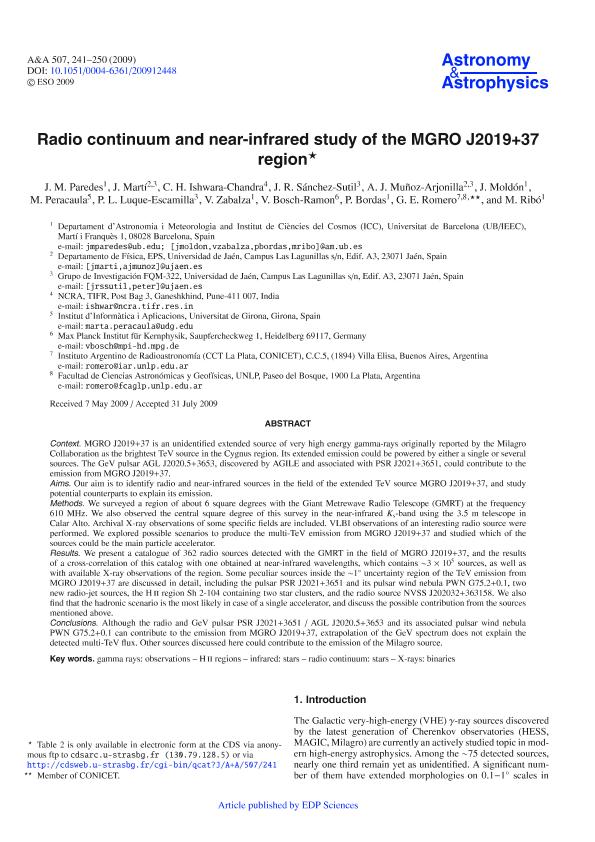Mostrar el registro sencillo del ítem
dc.contributor.author
Paredes, Josep Maria

dc.contributor.author
Martí, Josep

dc.contributor.author
Ishwara Chandra, C. H.
dc.contributor.author
Sánchez Sutil, J. R.
dc.contributor.author
Muñoz Arjonilla, Álvaro José

dc.contributor.author
Moldón, J.
dc.contributor.author
Peracaula, M.
dc.contributor.author
Luque Escamilla, Pedro L.

dc.contributor.author
Zabalza, V.
dc.contributor.author
Bosch Ramon, Valentí

dc.contributor.author
Bordas, Pol
dc.contributor.author
Romero, Gustavo Esteban

dc.contributor.author
Ribó, Marc
dc.date.available
2017-11-30T14:50:00Z
dc.date.issued
2009-11
dc.identifier.citation
Paredes, Josep Maria; Martí, Josep; Ishwara Chandra, C. H.; Sánchez Sutil, J. R.; Muñoz Arjonilla, Álvaro José; et al.; Radio continuum and near-infrared study of the MGRO J2019+37 region; EDP Sciences; Astronomy and Astrophysics; 507; 1; 11-2009; 241-250
dc.identifier.issn
0004-6361
dc.identifier.uri
http://hdl.handle.net/11336/29323
dc.description.abstract
Context. MGRO J2019+37 is an unidentified extended source of very high energy gamma-rays originally reported by the Milagro Collaboration as the brightest TeV source in the Cygnus region. Its extended emission could be powered by either a single or several sources. The GeV pulsar AGL J2020.5+3653, discovered by AGILE and associated with PSR J2021+3651, could contribute to the emission from MGRO J2019+37. Aims. Our aim is to identify radio and near-infrared sources in the field of the extended TeV source MGRO J2019+37, and study potential counterparts to explain its emission. Methods. We surveyed a region of about 6 square degrees with the Giant Metrewave Radio Telescope (GMRT) at the frequency 610 MHz. We also observed the central square degree of this survey in the near-infrared Ks-band using the 3.5 m telescope in Calar Alto. Archival X-ray observations of some specific fields are included. VLBI observations of an interesting radio source were performed. We explored possible scenarios to produce the multi-TeV emission from MGRO J2019+37 and studied which of the sources could be the main particle accelerator. Results. We present a catalogue of 362 radio sources detected with the GMRT in the field of MGRO J2019+37, and the results of a cross-correlation of this catalog with one obtained at near-infrared wavelengths, which contains ∼3 × 105 sources, as well as with available X-ray observations of the region. Some peculiar sources inside the ∼1◦ uncertainty region of the TeV emission from MGRO J2019+37 are discussed in detail, including the pulsar PSR J2021+3651 and its pulsar wind nebula PWN G75.2+0.1, two new radio-jet sources, the H ii region Sh 2-104 containing two star clusters, and the radio source NVSS J202032+363158. We also find that the hadronic scenario is the most likely in case of a single accelerator, and discuss the possible contribution from the sources mentioned above. Conclusions. Although the radio and GeV pulsar PSR J2021+3651 / AGL J2020.5+3653 and its associated pulsar wind nebula PWN G75.2+0.1 can contribute to the emission from MGRO J2019+37, extrapolation of the GeV spectrum does not explain the detected multi-TeV flux. Other sources discussed here could contribute to the emission of the Milagro source.
dc.format
application/pdf
dc.language.iso
eng
dc.publisher
EDP Sciences

dc.rights
info:eu-repo/semantics/openAccess
dc.rights.uri
https://creativecommons.org/licenses/by-nc-sa/2.5/ar/
dc.subject
Gamma Ray Observations
dc.subject
Hii Regions
dc.subject
Infrared Stars
dc.subject
Radio Continuum
dc.subject
X-Ray Binaries
dc.subject.classification
Astronomía

dc.subject.classification
Ciencias Físicas

dc.subject.classification
CIENCIAS NATURALES Y EXACTAS

dc.title
Radio continuum and near-infrared study of the MGRO J2019+37 region
dc.type
info:eu-repo/semantics/article
dc.type
info:ar-repo/semantics/artículo
dc.type
info:eu-repo/semantics/publishedVersion
dc.date.updated
2017-10-04T14:55:24Z
dc.journal.volume
507
dc.journal.number
1
dc.journal.pagination
241-250
dc.journal.pais
Francia

dc.journal.ciudad
Paris
dc.description.fil
Fil: Paredes, Josep Maria. Universidad de Barcelona; España
dc.description.fil
Fil: Martí, Josep. Universidad de Jaén; España
dc.description.fil
Fil: Ishwara Chandra, C. H.. National Centre for Radio Astrophysics; India
dc.description.fil
Fil: Sánchez Sutil, J. R.. Universidad de Jaén; España
dc.description.fil
Fil: Muñoz Arjonilla, Álvaro José. Universidad de Jaén; España
dc.description.fil
Fil: Moldón, J.. Universidad de Barcelona; España
dc.description.fil
Fil: Peracaula, M.. Universidad de Girona; España
dc.description.fil
Fil: Luque Escamilla, Pedro L.. Universidad de Jaén; España
dc.description.fil
Fil: Zabalza, V.. Universidad de Barcelona; España
dc.description.fil
Fil: Bosch Ramon, Valentí. Max Planck Institut für Kernphysik; Alemania
dc.description.fil
Fil: Bordas, Pol. Universidad de Barcelona; España
dc.description.fil
Fil: Romero, Gustavo Esteban. Provincia de Buenos Aires. Gobernación. Comisión de Investigaciones Científicas. Instituto Argentino de Radioastronomía. Consejo Nacional de Investigaciones Científicas y Técnicas. Centro Científico Tecnológico Conicet - La Plata. Instituto Argentino de Radioastronomía; Argentina
dc.description.fil
Fil: Ribó, Marc. Universidad de Barcelona; España
dc.journal.title
Astronomy and Astrophysics

dc.relation.alternativeid
info:eu-repo/semantics/altIdentifier/url/http://www.aanda.org/component/article?access=bibcode&bibcode=&bibcode=2009A%2526A...507..241PFUL
dc.relation.alternativeid
info:eu-repo/semantics/altIdentifier/doi/http://dx.doi.org/10.1051/0004-6361/200912448
Archivos asociados
